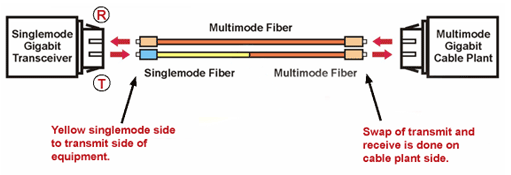I first wrote about the potential issues with 10Gbps connectivity across a legacy fiber cable plant back in 2009 in an article titled, 10GBase-SR and Fiber Cable Plants. I just recently had another run into this same issue while working a consulting engagement. The customer had a legacy 62.5µm multimode fiber network that was currently running 1Gbps via 1000BaseSX GBIC transceivers. The customer was replacing their aging Cisco switches with HPE Aruba 2920 switches trying to use 10GBaseSR SFP+ transceivers. I was contracted to configure the HPE Aruba switches but when things didn’t work I had to dig through what the pre-sales team had assembled for the reseller and quickly found that someone had made some major mistakes in the design.
The customer believed that their fiber cable plant had 62.5µm multimode fiber and a spot check of the cable sheathing in a few locations confirmed as much. Unfortunately the fiber runs were believed to be between 200ft and 400ft in distance. With a 1000BaseSX transceiver you can reach 220m (721ft) over 62.5µm (OM1) fiber plant. With a 10GBaseSR transceiver you can only achieve 33m (108ft) over 62.5µm (OM1) fiber plant. That’s a pretty big difference and the primary reason why this initial upgrade attempt failed.
There is good news though for those with a legacy 62.5µm fiber cable plant, there’s no need to go tearing out that legacy fiber. The industry and the IEEE has provided a solution in 10GBaseLRM. The 10GBaseLRM transceiver can potentially reach 220m (721ft) over 62.5µm (OM1) fiber plant when combined with a special mode conditioning fiber patch cable. What’s a mode conditioning patch cable (MCPC)? It’s a special patch cable that has a small piece of singlemode fiber fusion spliced onto a multimode fiber.

Since singlemode fiber is usually only 9µm and multimode fiber can be either 50µm or 62.5µm the center of each fiber doesn’t match up when paired together, hence the mode conditioning fiber patch is required to help align the signal as it leaves the transceiver and hits the fiber cable plant.
The moral of this story, make sure you do the proper research and always verify that your fiber cable plant will be in spec for the transceiver you’re going to be using in your solution.
Cheers!
Interesting product idea. I will check it out. Fiber is pretty misunderstood by a lot of IT people. I can’t count how many times in any given year I ask someone what type of fiber they need and they say, “the cheapest quote.” Inevitably they end up with OM1 fiber and potential problems down the road. It has been my experience that most people understand Cat3 is not an acceptable solution for copper. But I find even many people in IT don’t understand the differences in Fiber.
Thanks for the comment Del.
I like to refer to those folks as part-time IT people, they are just here because we’re cool to hang out with.
:)
Been there, got that t-shirt. A natural gas plant called me in to connect up some new equipment they bought. They got some nice 10Gig fiber switches. But their fiber infrastructure was old FDDI grey fiber cabling. No way was it ever going to work as FDDI cable isn’t even OM1 level. Had to leave their old existing switches in that could work on the old FDDI stuff at 100Mb and use them essentially as copper to fiber converters.
Thanks for the comment Telair!
I still see folks splitting pairs between telephones and networking to the desktop and then asking why 1Gbps doesn’t work.
Cheers!